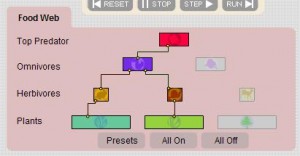An interactive lab that allows you to create your own ecosystem.
http://www.learner.org/courses/envsci/interactives/ecology/
The Ecology lab simulation allows you to create ecosystems where the type of species can be varied, and then the interrelationships between those species can be seen as they interact. Though this is a simple simulation, it can help to explain some of the phenomena discussed in the Zhao and Frank article.
According to Zhao and Frank, schools and their classrooms represent ecosystems. In those ecosystems, there are a variety of species which interact; where the authors view species as being people and things in that ecosystem. Teachers are an example of a keystone species as they have a disproportionate effect on the ecosystem. In real ecosystems, keystone species are not necessarily the top predators. In the Great Lakes, the keystone species in the mussel ecosystem is actually a small invertebrate that eats the same thing as the Zebra mussels eat. Students are important species, but do not typically have as large of an impact on the ecosystem as the keystone species. This principle can be applied to the introduction of technology in schools, where teacher have a greater influence than students.
An important concept that Zhao and Frank introduce is homeostasis, where the ecosystem reaches equilibrium and species type and number remain relatively constant. Using the simulation, watch how homeostasis is established in an ecosystem where there are two plant species (producers), two herbivores, one omnivore and one top predator (set up like the diagram below).
To simulate an invading species, stop the simulation and add a species (plant, herbivore or omnivore) and click “run” to see how the populations of all species are affected. Reset with the original setting (like the picture above) and select a new invading species. This time, try to predict which species will be most affected and whether the invasion will be successful or not. Click “run” as before and watch until homeostasis is achieved. Did the other species react as you thought and was the invasion successful? Can a keystone species be identified?
Because schools are dynamic environments with many competing factors, it can be difficult to develop a framework to describe how change comes about. Zhao and Frank applied an ecosystem model to try to explain how technology is incorporated into schools. Using an ecosystem model, like the simulation that you used, hopefully you can better understand how dynamic systems can be explained.
Looking forward to the dicsussion questions, can this simulation accurately describe how technology is integrated into schools? Can it explain how the integration of smart devices (phones, tablets, etc…) can be integrated? What do these devices represent in the ecosystem framework (bearing in mind that this may be thought of as a ‘top-up’ movement to integrate rather than a ‘bottom-down’ movement)?

